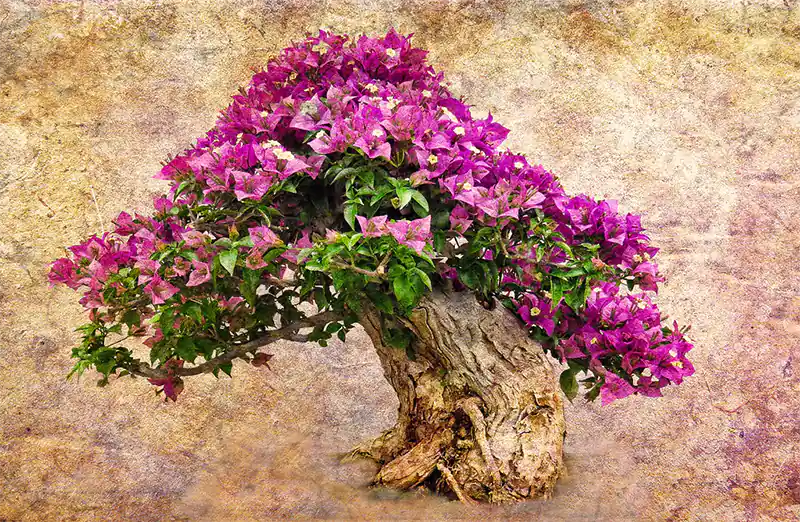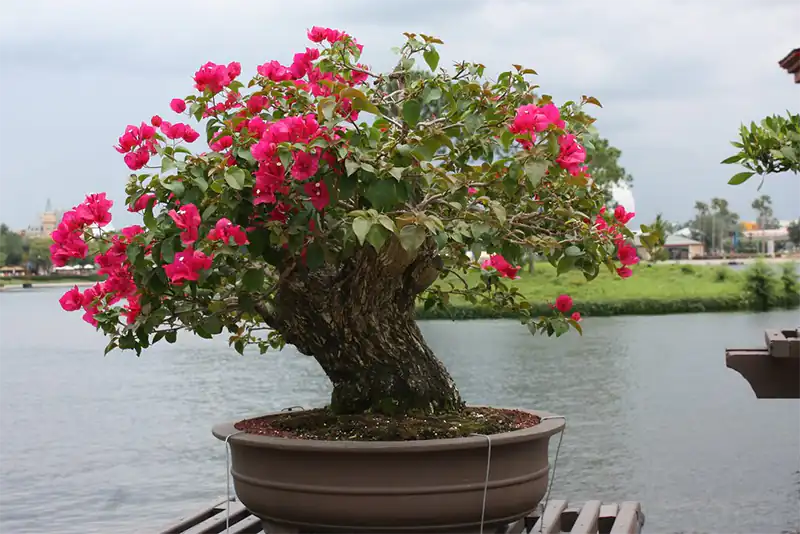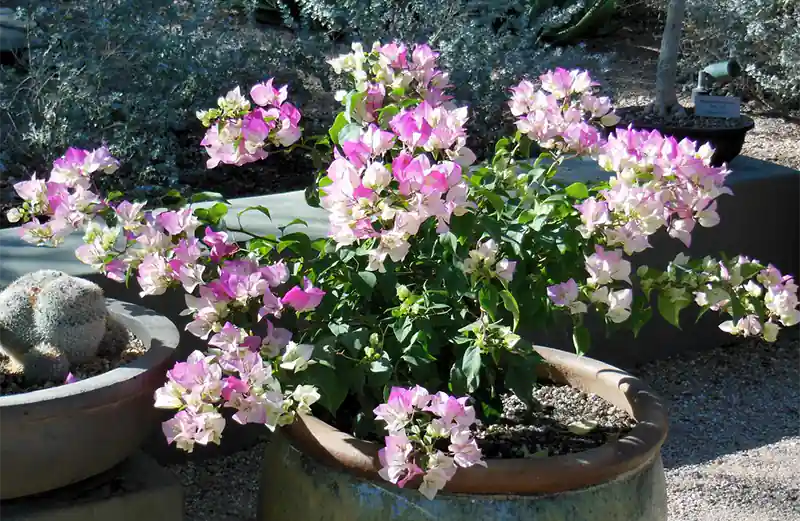Bougainvillea Tree Shaping: How To Style Your Bonsai
While owning one of these magnificent trees presents an outstanding experience, learning Bougainvillea tree shaping will help you develop the design you want. There are many ways you can try, but not all of them have the same measure of success.
Join us as we show you the best ways to shape and style your Bougainvillea bonsai tree.

Image courtesy of 4.0 International
Here are the topics we’ll cover:
Here are the topics we’ll cover:
Can You Shape a Bougainvillea Bonsai Tree?
While many consider the genus to contain vines and bushes, Bougainvillea tree shaping on a bonsai is possible. There are many examples of enthusiasts showing off their various styles, at home and at festivals. Even gardeners at home enjoy creating wonderful designs on trellises and down walls.
However, you need to take extreme care when bending and shaping your Bougainvillea tree. The young stems break easily, and you may knock off the fragile leaves. In the following sections, we’ll show you which aspects to consider and how to do it carefully.
Should Bougainvillea Be Pruned?
When the growing seasons arrive and you supply sufficient water and fertilizer, you’ll see new buds and shoots appear at incredible speed. As you don’t want your bonsai to grow too large, it’s essential that you prune it for effective Bougainvillea tree shaping. The first few months are the most significant, as that’s when the initial burst of leaves appears.
When your Bougainvillea is done flowering, you should also lightly prune some leaves and branches back if you want to encourage another round of development. You can make your bonsai tree bushier this way, while also removing any dead twigs along the way to make it stronger and healthier.

Image courtesy of 4.0 International
Training A Bougainvillea Bonsai
You don’t have to wait for your Bougainvillea bonsai to develop a mass of foliage before you start with tree shaping. It all begins before that with the training. If you wait too long, you won’t be able to develop the ramifications towards the style you want.
Here’s a quick guide on how to train your Bougainvillea bonsai tree:
- Research the various styles (we have some information lower down in this article)
- Decide which shape you want to aim for
- Select the main trunk and a few select strong branches that will work for the proposed design
- Remove any other shoots or branches you don’t need with sterilized pruning shears or lobbers
- If you want a braided look, you can choose three main stems and wind them around each other carefully while they’re still young and soft
- Insert a stake at least 6 inches into the soil and gently tie the main stem to it with twine
- Don’t use bonsai wire, as it may cut into the soft trunk
- Allow the Bougainvillea to reach the height you want before cutting back 3 inches to encourage branching
- Let the new shoots follow the shape you want, extending past the lengths you desire before cutting them back
- Every season, let the new growths develop and prune them to the final shape you imagined at the start
How Do You Shape A Bougainvillea Bonsai Tree?
Now that you know how to train it, it’s time to show you the best way to accomplish Bougainvillea tree shaping. There are three primary methods enthusiasts use to obtain the final design they want. Each of these has its merits, but we do prefer the clip-and-grow technique the most.
Wiring
The most popular form of shaping a bonsai tree is wiring, either via copper or aluminum wire. You gently tie one end around the base of the Bougainvillea’s branch or trunk while winding the rest along the height or length. You’ll need to avoid passing the wire over nodes, as it will damage the leaves.
Why we don’t like this method for Bougainvillea tree shaping is that it may cut into the stem and injure it. When they are young, they are easier to bend due to the soft, flexible structure, but they are also easier to break. As the branch matures, you won’t be able to shape it as much, as you may crack the interior.
Another concern is when the next spring arrives and the trunk or branches swell. If you don’t loosen the wire, it will also damage the tree. So it becomes a stressful time for you and your bonsai, which is not ideal. We’re not saying you shouldn’t do it, but we do want to make you aware of the potential consequences.
Weight Clips
One technique for Bougainvillea tree shaping we enjoy is called weighting. You tie a small string to a branch at the point where you want it to bend and attach a light clip to it. The weight has to be enough to keep the angle in place without snapping the limb. It creates a more natural curve than wiring, and you can play with bending designs along the length of the trunk.
To prevent hurting the bark or branch, you need to place a small cloth on the area where the string will rest. In a way, it’s slightly riskier than wiring, as the string may bite into it or the excess weight could cause the branch to snap. You need to find the right age and thickness to apply this technique correctly.
Clip and Grow
By far, our favorite method is clip and grow. As the name implies, you’ll let the branch or stem grow to a specific length, clip it, let the new shoots grow out, and clip again. In this way, you can direct the direction of growth to where you want it without attaching weights or using wires.
Of course, you can use a combination of three. There’s no reason you can’t clip and grow, then apply weight clips for a small bend, and finishing off with wires at the end. You can also tie a wire to a rock or drainage holes and then attach it to the stem to pull it down into slanting or cascading.

Image courtesy of 4.0 International
Various Bougainvillea Styles
So, why would you attempt Bougainvillea tree shaping? Why don’t you just let it grow as it wishes? Well, bonsai is an art form, and you’ll be aiming to create a specific style. While there are plenty available you can try, we have a few specific ones we prefer for these species.
Don’t be limited by what we suggest. You can go ahead and craft your own concepts, which is what many do today. However, they use some of these are the foundation for their designs.
Formal Upright and Broom
This style gets its name from a straight trunk that tapers to the top. The apex is in line with the base of the bonsai tree while the stem doesn’t deviate from a straight line. Usually, you’ll see branch tiers are various levels up the height, with the lower ones being longer than the upper ones.
Another popular choice for Bougainvillea tree shaping is the broom style. It uses the formal upright design, but you’ll remove all the branches until the main foliage at the top. Here you’ll create ramifications so that there are only leaves at the apex, spreading out horizontally.
Informal Upright
Similar to the above style is informal upright. It also has the apex in line with the base. However, the primary difference is that the trunk bends and twists on the way there, steering away from a straight line.
Some people try twin or multiple trunking that slants to the side before the stems go upright again. The limbs may even meet at the top again for a unique design, which will make the bracts on your Bougainvillea bonsai look outstanding. It requires significant planning and bending to achieve.
Slanting
If you want to aim for the windswept look, you can use the slanting Bougainvillea tree shaping method. The trunk leans at an angle from the soil, while you’ll have the branches parallel to the container. We’ve tried this technique for a few of our species and absolutely love the appearance.
The best way to approach the slanting style is by tying a wire to the stem and a rock on the soil, pulling it down at the angle you desire. You can also loosely fix a stake to the trunk to keep it straight. As the branches break out, you can use wiring or weight clips to keep them level or let them grow naturally at an angle.
Cascading
There are two types of cascading styles you can use. Out of all the Bougainvillea tree shaping you can try, this one is probably more natural. The species is naturally a vine or bush in the wild, and it will take well to bending over the side of your container.
Wires and weight clips combine to make this shape. Semi-cascading bends the trunk over the side, but the apex won’t go further than the bottom of the container. Cascading also goes over the side, but it will reach go past the end of the pot.
Landscaping
Finally, we want to encourage you to make an interesting landscaping design. Play with small ornaments or sand designs above the soil to add to the atmosphere of your Bougainvillea bonsai. You can even try and grow moss for a more authentic appearance.
We don’t recommend trying the forest style. Bougainvilleas need loads of space for the bush foliage, and trying to develop more than one tree in one pot won’t look too good. We recommend only using that for species with smaller leaves, such as the Italian Cypress.

Image courtesy of 4.0 International
Final Thoughts On Bougainvillea Tree Shaping
Bougainvillea tree shaping is a fun experience, and you can create stunning designs that will drop the jaw of friends and family. We’ve seen many styles on Instagram and Pinterest, many of which have impressed us. If you have created a unique shape, please feel free to share it with us.







